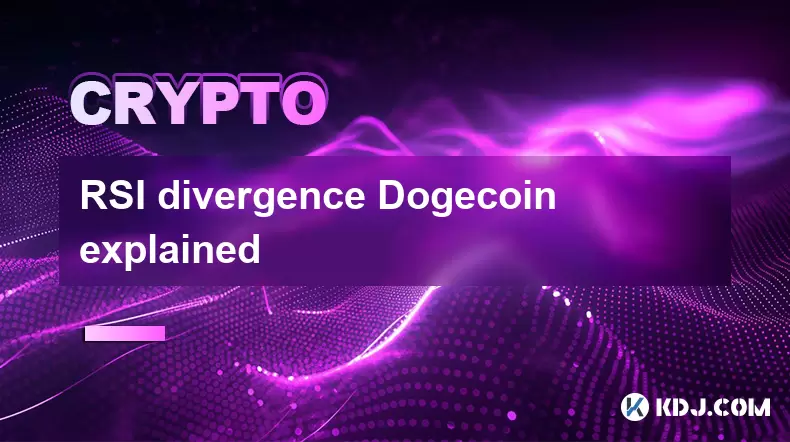-
 bitcoin
bitcoin $124586.364639 USD
0.62% -
 ethereum
ethereum $4670.671710 USD
3.33% -
 xrp
xrp $2.983701 USD
0.18% -
 tether
tether $1.000175 USD
-0.03% -
 bnb
bnb $1209.430642 USD
2.76% -
 solana
solana $231.365861 USD
0.51% -
 usd-coin
usd-coin $0.999665 USD
-0.02% -
 dogecoin
dogecoin $0.264657 USD
4.46% -
 tron
tron $0.346415 USD
1.60% -
 cardano
cardano $0.871586 USD
3.70% -
 chainlink
chainlink $23.451270 USD
7.56% -
 hyperliquid
hyperliquid $46.860071 USD
-2.96% -
 ethena-usde
ethena-usde $1.000120 USD
0.04% -
 sui
sui $3.611279 USD
1.08% -
 stellar
stellar $0.407149 USD
0.96%
RSI divergence Dogecoin explained
RSI divergence occurs when Dogecoin's price and RSI move in opposite directions, signaling potential trend reversals.
Jul 07, 2025 at 05:49 am

What Is RSI Divergence and Why Does It Matter for Dogecoin?
RSI divergence refers to a scenario in technical analysis where the Relative Strength Index (RSI) indicator moves in the opposite direction of the price action. In simpler terms, when Dogecoin’s price makes a new high but the RSI fails to confirm it, or when the price hits a new low while the RSI forms a higher low, this is known as divergence.
This phenomenon often signals that the current trend may be weakening. For Dogecoin traders, identifying RSI divergence can be crucial because it helps anticipate potential reversals. Since Dogecoin is known for its volatile nature, spotting these early signs can help traders make informed decisions on when to enter or exit positions.
The importance lies in how RSI divergence acts as a leading indicator, unlike many lagging indicators such as moving averages. This gives traders an edge by allowing them to spot potential market shifts before they fully materialize.
How to Identify RSI Divergence in Dogecoin Charts
Identifying RSI divergence involves comparing price action with the RSI values on a chart. There are two main types of divergence: regular and hidden. Let's explore how each appears in Dogecoin charts:
- Regular bullish divergence: This occurs when Dogecoin makes a lower low in price, but the RSI makes a higher low, suggesting weakening bearish momentum.
- Regular bearish divergence: When Dogecoin reaches a higher high, but the RSI peaks at a lower high, indicating fading bullish strength.
- Hidden bullish divergence: Seen during uptrends, where Dogecoin pulls back slightly but the RSI makes a higher low, signaling continuation.
- Hidden bearish divergence: Occurs in downtrends when Dogecoin briefly rallies but the RSI makes a lower high, pointing to ongoing weakness.
To identify these patterns effectively, you should use candlestick charts and overlay the RSI indicator (typically set to 14 periods). Look for mismatches between price highs/lows and RSI highs/lows across multiple swing points.
Setting Up Your Chart to Spot RSI Divergence in Dogecoin
Before diving into actual divergence identification, setting up your chart correctly is essential. Here’s how to do it step-by-step:
- Open a charting platform like TradingView or Binance’s native chart tool.
- Select Dogecoin/USDT or Dogecoin/BTC depending on your trading pair preference.
- Apply the Relative Strength Index (RSI) indicator, usually found under the oscillator section.
- Ensure the RSI is set to the standard 14-period setting, though some traders tweak it for sensitivity.
- Zoom out to a timeframe suitable for spotting trends — 1-hour, 4-hour, or daily charts work best for divergence analysis.
- Enable drawing tools to mark swing highs and lows on both price and RSI lines.
Once the setup is complete, start scanning for discrepancies between price movement and RSI readings. Make sure to draw trendlines connecting RSI peaks and troughs to visualize divergence more clearly.
Common Mistakes Traders Make When Using RSI Divergence on Dogecoin
Even experienced traders can fall into common traps when interpreting RSI divergence in Dogecoin markets. One of the most frequent errors is trading divergence in isolation without confirming signals from other indicators or chart patterns.
Another mistake is ignoring the broader market context. For instance, if Dogecoin is in a strong uptrend driven by social media hype or celebrity endorsements, a bearish divergence might not result in a reversal immediately. Similarly, during sharp corrections, false divergences can appear due to volatility spikes.
Additionally, some traders mislabel minor fluctuations as valid divergence. A true divergence requires clear and distinct swing highs or lows on both the price and RSI. Rushing into trades based on ambiguous setups can lead to losses.
Lastly, using non-adjusted RSI settings for highly volatile assets like Dogecoin can create misleading signals. Some traders adjust RSI sensitivity by increasing or decreasing the period value, but this must be tested thoroughly before live trading.
Practical Example of RSI Divergence in Dogecoin Trading
Let’s walk through a real-world example of how RSI divergence could play out in Dogecoin trading:
Imagine Dogecoin has been rising steadily over several days. On the chart, you notice that the price makes a new high, say $0.085, followed by another peak at $0.087. However, when looking at the RSI line, the first peak shows an RSI reading of 72, while the second peak only reaches 68.
This bearish regular divergence suggests that despite the price climbing, the momentum behind the rally is weakening. You decide to monitor the situation further and see volume declining during the latest price push. This confirms that fewer buyers are stepping in.
You then wait for confirmation signals such as a bearish candlestick pattern or a break below a key support level. Once those appear, you place a short trade or close long positions with a stop-loss above the recent high.
In this case, the price indeed drops afterward to $0.075, giving you a favorable risk-to-reward ratio if managed properly.
Frequently Asked Questions About RSI Divergence and Dogecoin
Q: Can RSI divergence be used for intraday Dogecoin trading?Yes, RSI divergence can be applied to shorter timeframes like 15-minute or 30-minute charts. However, due to increased noise and volatility in short-term Dogecoin movements, it's important to combine divergence signals with other confirmation tools like volume or candlestick patterns.
Q: Are there any specific RSI settings better suited for Dogecoin?While the default 14-period RSI works well, some traders prefer adjusting the period count for faster signals. Lower values like 10 or 12 increase sensitivity, while higher values like 20 or 25 smooth out the signal. Always backtest adjustments before applying them in live trading.
Q: How reliable is RSI divergence in predicting Dogecoin price reversals?RSI divergence is not 100% accurate and should never be used in isolation. Its reliability increases when combined with other technical tools like trendlines, Fibonacci levels, or moving averages. Additionally, understanding the broader sentiment around Dogecoin, including news events or community activity, enhances accuracy.
Q: Can divergence occur even when the RSI isn’t in overbought or oversold territory?Absolutely. While divergence is often spotted near extreme RSI levels (above 70 for overbought, below 30 for oversold), it can also form within the neutral zone (between 30–70). These mid-zone divergences can sometimes indicate stronger reversals since they reflect early shifts in momentum.
Disclaimer:info@kdj.com
The information provided is not trading advice. kdj.com does not assume any responsibility for any investments made based on the information provided in this article. Cryptocurrencies are highly volatile and it is highly recommended that you invest with caution after thorough research!
If you believe that the content used on this website infringes your copyright, please contact us immediately (info@kdj.com) and we will delete it promptly.
- BlockDAG, DOGE, HYPE Sponsorship: Crypto Trends Shaping 2025
- 2025-10-01 00:25:13
- Deutsche Börse and Circle: A StableCoin Adoption Powerhouse in Europe
- 2025-10-01 00:25:13
- BlockDAG's Presale Buzz: Is It the Crypto to Watch in October 2025?
- 2025-10-01 00:30:13
- Bitcoin, Crypto, and IQ: When Genius Meets Digital Gold?
- 2025-10-01 00:30:13
- Stablecoins, American Innovation, and Wallet Tokens: The Next Frontier
- 2025-10-01 00:35:12
- NBU, Coins, and Crypto in Ukraine: A New Yorker's Take
- 2025-10-01 00:45:14
Related knowledge

Bitcoincoin burning mechanism
Jul 20,2025 at 09:21pm
What is the Dogecoin burning mechanism?The Dogecoin burning mechanism refers to the process of permanently removing DOGE tokens from circulation by se...

How to earn free Bitcoincoin?
Jul 19,2025 at 10:08pm
What is Dogecoin and Why Earn It?Dogecoin (DOGE) started as a meme-based cryptocurrency in 2013 but has grown into a widely recognized digital asset. ...

Is Coinbase a good wallet for Bitcoincoin?
Jul 19,2025 at 04:42pm
Understanding Coinbase as a Wallet Option for DogecoinWhen considering where to store Dogecoin, Coinbase is often mentioned as a potential option due ...

How to buy Bitcoincoin with PayPal?
Jul 23,2025 at 06:57am
Understanding the Basics of Buying DogecoinBefore diving into the process of buying Dogecoin with PayPal, it’s essential to understand what Dogecoin i...

Best app to buy Dogecoin
Jul 23,2025 at 03:08pm
What Is a Cryptocurrency Exchange and How Does It Work?A cryptocurrency exchange is a digital marketplace where users can buy, sell, or trade cryptocu...

How are Dogecoin gains taxed?
Jul 25,2025 at 07:01am
Understanding the Taxation of Dogecoin GainsWhen it comes to Dogecoin (DOGE), many investors are drawn to its meme-inspired branding and volatile pric...

Bitcoincoin burning mechanism
Jul 20,2025 at 09:21pm
What is the Dogecoin burning mechanism?The Dogecoin burning mechanism refers to the process of permanently removing DOGE tokens from circulation by se...

How to earn free Bitcoincoin?
Jul 19,2025 at 10:08pm
What is Dogecoin and Why Earn It?Dogecoin (DOGE) started as a meme-based cryptocurrency in 2013 but has grown into a widely recognized digital asset. ...

Is Coinbase a good wallet for Bitcoincoin?
Jul 19,2025 at 04:42pm
Understanding Coinbase as a Wallet Option for DogecoinWhen considering where to store Dogecoin, Coinbase is often mentioned as a potential option due ...

How to buy Bitcoincoin with PayPal?
Jul 23,2025 at 06:57am
Understanding the Basics of Buying DogecoinBefore diving into the process of buying Dogecoin with PayPal, it’s essential to understand what Dogecoin i...

Best app to buy Dogecoin
Jul 23,2025 at 03:08pm
What Is a Cryptocurrency Exchange and How Does It Work?A cryptocurrency exchange is a digital marketplace where users can buy, sell, or trade cryptocu...

How are Dogecoin gains taxed?
Jul 25,2025 at 07:01am
Understanding the Taxation of Dogecoin GainsWhen it comes to Dogecoin (DOGE), many investors are drawn to its meme-inspired branding and volatile pric...
See all articles










































































